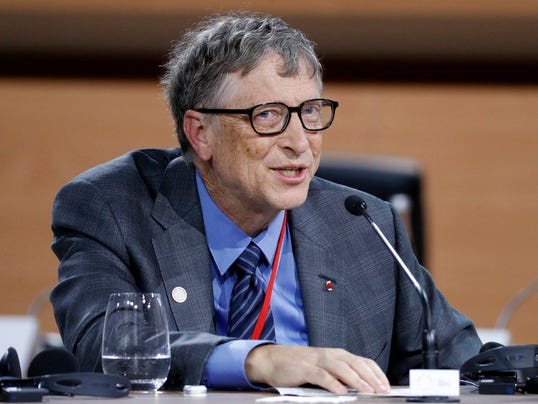Vast majority of new wealth last year went to top 1%
Kim Hjelmgaard, USA TODAYCharity Oxfam says four out of every five dollars of wealth generated in 2017 ended up in the pockets of the richest one percent, while the poorest half of humanity got nothing.

(Photo: EPA)
A new billionaire is created every other day. The three richest Americans have the same amount of wealth as the poorest half of the U.S. population. And 82% of the global wealth generated last year went to just 1% of the world's population.
These are among the findings of a study released Sunday by Oxfam, a British campaigning group, as political and business leaders, including President Trump, prepared to gather in Davos, Switzerland, for the World Economic Forum’s annual meeting. Income inequality will be a major topic at the conference, which runs from Tuesday through Friday.
“There’s a billionaire boom,” said Paul O’Brien, Oxfam America’s vice president for policy and campaigns. “A perfect storm is driving up the bargaining power of those at the top while driving down the bargaining power of those at the bottom. If such inequality remains unaddressed, it will trap people in poverty and further fracture our society.”
There are now 2,043 billionaires worldwide, according to the report, “Reward Work, Not Wealth.” Nine out of 10 of them are men. Collectively, their fortunes grew by $762 billion in 2017, while the poorest half of humanity saw no increase in their wealth at all.
The study relied on data and research compiled by Swiss bank Credit Suisse, the World Bank, Forbes' billionaires list, the International Monetary Fund and others.
Previous Oxfam reports have shown the world’s richest 1% own more wealth than the rest of the global population combined, a trend that is reaffirmed in the latest edition.
It also showed that 42 people in 2017 had wealth equivalent to the world’s poorest 3.7 billion people. The figure for 2016 was revised from eight to 61 people.
Microsoft founder and philanthropist Bill Gates, Amazon’s Jeff Bezos and legendary investor Warren Buffett are the three Americans whose combined wealth matches that of the poorest 160 million Americans — about $250 billion.
Oxfam said the massive inequality is being driven by factors that include excessive financial returns to company owners and shareholders at the expense of ordinary workers and the rest of the economy; the ability of rich individuals and corporations to use tax havens that allow them to evade or shield trillions of dollars from tax authorities; public policy that permits market conditions that push down wages and infringe on labor rights; and extreme wealth that is inherited, not earned.
Over the next 20 years, the report found, 500 of the world’s richest people will give $2.4 trillion to their heirs — a sum larger than the GDP of India, which has 1.3 billion people.
“Inequality is reaching such extreme levels that it might actually be bad for really wealthy people because it’s slowing down economic growth and leading to political disruption,” said David Hulme, an expert global development at the University of Manchester.
Hulme added that “globally, across the world’s 7.6 billion people, extreme poverty is actually reducing. It’s only when you look at the top group, the richest people, that wealth is concentrating amazingly. Both of those things can happen at the same time.”
In fact, from 1990 to 2010, the number of people living in extreme poverty — defined as on less than $1.90 a day — was cut in half, and has continued to decline, Oxfam said.
The World Inequality Report 2018, a separate report published in December last year, noted that income inequality varies greatly across the world. When defined as the share of total national income accounted for by a nation’s top 10% earners, it is lowest in Europe (37%) and highest in the Middle east (61%). The United States (47%) lags China (41%) and Russia (46%).
The Institute for Policy Studies, a think tank, warned in November that President Trump’s tax reforms would “exacerbate existing wealth disparities.” Trump lowered the tax on American corporations from 35% to 21%. The White House argues it will prevent U.S. companies from relocating operations abroad and allow them to hire more workers.
No comments:
Post a Comment